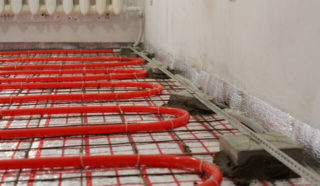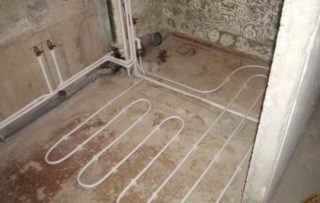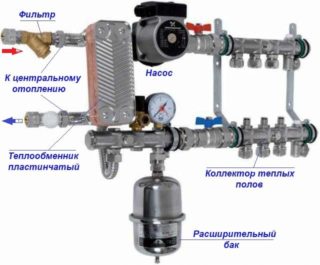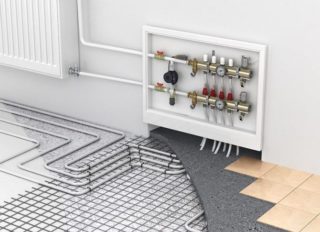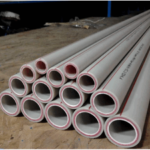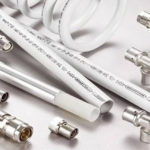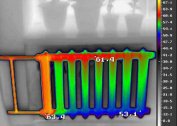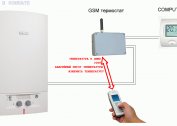Housing standards do not allow residents of high-rise buildings to arbitrarily connect to the heating main. Permission is required to make underfloor heating from central heating in the apartment. Waterproofing will prevent leaks, and dismantling several radiators will keep pressure in the system.
Restrictions when connecting a warm floor from central heating
The heating water floor refers to systems with high temperatures, therefore, according to the norms, the heat carrier cannot heat more than + 55 ° С. In practice, pipes receive +35 - 45 ° C.
The temperature of the water and the floor is different, it is recommended to heat the surface:
- in living rooms - up to + 26 ° С;
- in the premises of the kitchen, corridor, bathroom, balcony, loggia - up to + 31 ° C.
The difference in the heating rate between the supply and return side must not exceed 10 ° C.
Wiring diagrams
The principle of underfloor heating is based on the principle of connecting a low-temperature circuit. The correct scheme ensures the flow of coolant through the riser, which is located separately from the radiator pipe. It can be a heat exchanger at a common heat point, a node in a high-rise building or in a consumer's home. The scheme is negotiated with the heat supplier and the management office. In practice, the floor is connected according to one of the schemes, permission is issued in half the cases.
Radiator connection
The system is made in the form of two pipelines. After tapping, a stopcock is placed in the main riser, on each battery - 2 valves per return and supply line. The material of the circuits is 25 mm polypropylene, and the heat exchangers are connected by a 20 mm pipe.
If there is a return line on the upper highway from the bottom and a supply to the battery from above, the floor heating works efficiently. On the lower branch, the return and feed are supplied from below, so only 85% of the energy is used.
Connection via a heating radiator to a regulator
RTL-type thermal heads control the temperature of the heating medium with a direct connection of the water heating floor.
An automatic valve crashes on the return and coordinates the set temperature:
- water has not reached the set value - uninterrupted circulation is allowed;
- the temperature rises to normal - the head actuator shuts off the valve, the fluid supply stops;
- cooling leads to the opening of the passage and the movement of water.
Connection through a radiator to the regulator helps to reduce surface heating to a comfortable perceived value. Requires the installation of a thermal head and a three-way valve.
Connection via heat exchanger
Such a scheme eliminates the negative effects of a warm water floor in an apartment with central heating.
The heat exchanger is selected in accordance with the power of the batteries, installed in place of the radiator and performs the following functions:
- preserves the hydraulic section of the line;
- allows you to independently control the heating of two circuits.
The heated floor pipe does not have direct access to the common system; in case of an accident, it is not necessary to disconnect the common riser from the boiler. The risk of flooding of neighbors from below in an apartment building is reduced.
Serial connection
To power the underfloor heating from a single pipe system, you need to include a pump and a mixing unit in the connection diagram.
During installation, the following conditions are met:
- the inner diameter of the supply pipes is not less than 25 mm, while the largest number of batteries on the ring should not exceed 5;
- the water floor loop is connected to the return pipe after all radiators;
- in order to maintain the required temperature, a three-way mixing valve crashes.
This connection is used by owners of old-type apartments for unauthorized tapping into a single-pipe riser of a vertical type.
Horizontal wiring
The design layout of the pipes is used, providing a rhythmic distribution of heat over the area. This takes into account the distance from the vertical fences and the layout of the furniture. Such horizontal wiring planning allows the efficient use of coolant energy in pipes.
The collector-beam pipe arrangement is popular. The collectors are installed so that the size of the laid sections between the floor heating zones and the distributors is the smallest. This helps to balance the highway and coordinate the temperature in different rooms.
Pipe selection
The materials used have similar properties and are used for underfloor heating systems. Durability is characterized by copper pipes, but they are expensive, which limits the application. Polymeric materials are affordable and provide the necessary performance during operation.
Crosslinked Polyethylene
It is characterized by acid resistance, high wear resistance and flexibility.
The following types are available:
- rePEX - with an internal anti-diffusion coating, used for underfloor heating;
- PEX - for cold and hot supply;
- evalPEX - for radiator heating.
The disadvantages are manifested in the impossibility of welding, so the entire section changes during an accident. An external insulation is used to limit heat loss.
Polypropylene Composition
Advantages are good sound insulation and low friction, which leads to the preservation of the flow rate.
Views:
- PN10 - cold water;
- PN20 - hot;
- PN25 - heating (with internal reinforcement).
Polypropylene pipes do not conduct heat well, therefore they do not require a protective layer, are impervious to acids and have a low price. The disadvantages include a short lifetime - about 30 years.
Copper
High quality copper or zinc-copper alloys (zinc 5%) are used. Pipes are externally coated with a layer of polyethylene or polyvinyl chloride to reduce heat loss. For heating systems, products with the EN 1057 marking are used, indicating phosphorus treatment to increase resistance to moisture.
Copper is not susceptible to corrosion, has strength, and therefore is used up to 100 years. The pipes withstand temperatures from -100 ° C to + 250 ° C without cracking or deformation.
Metal plastic
The material is characterized by a low elongation index, which approaches metal. Flexibility allows laying collectors in hard-to-reach places. High-quality metal-plastic has a high price and is not connected by welding.
Thermal conductivity with a coefficient of 0.45 expands the scope of application of pipes, the material works effectively in a warm water floor system.
- Polypropylene
- Metal plastic
- Copper pipes
The nuances of connecting a warm floor from central heating
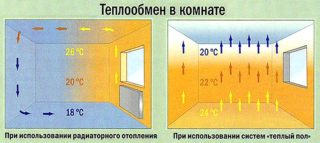 Before installing the pipes, preparation of the floor surface is required. This will reduce the risk of poor heating performance. It is better to entrust the installation of the system to specialists - it will be safer this way, the risk of emergency situations will be reduced.
Before installing the pipes, preparation of the floor surface is required. This will reduce the risk of poor heating performance. It is better to entrust the installation of the system to specialists - it will be safer this way, the risk of emergency situations will be reduced.
The quality of the wiring and installation of the elements will affect the life of the water floor, heating efficiency, safety. Professional plumbers from the service office provide a warranty period for identifying problems.
Warm floor or radiator
With an underfloor heating system, the legs will always be warm.Comfort matters when choosing a room heating method.
Radiators dry the air in the apartment and contribute to the deterioration of health, underfloor heating does not have such an effect on the atmosphere.
In the harsh Russian climate, only a warm floor will not be enough - the house will not completely warm up. Experts advise installing a warm water floor system at the same time and leaving batteries in the room for efficient heating of the area.
